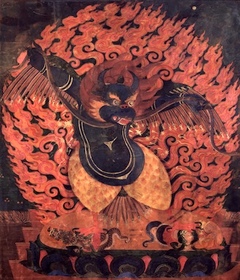Synopsis of the Fully Fledged Garuḍa
Synopsis of the Fully Fledged Garuḍa
by Longchen Rabjam
Homage to glorious Samantabhadra!
As regards the meaning of the unsurpassable secret teachings of Trekchö and Tögal, The Fully Fledged Garuḍa brings together and summarizes the crucial points on the meaning of non-meditation in Trekchö. It has three main sections:
1) a brief presentation of the essential causal elements that introduce the instruction
2) an elaborate explanation of the nature by means of the main instruction
3) a summary of both by means of the concluding points that complete the instruction.
I. A BRIEF PRESENTATION OF THE ESSENTIAL CAUSAL ELEMENTS THAT INTRODUCE THE INSTRUCTION
This has three parts:
1) a brief presentation of the essence by setting down the title
2) an extensive explanation of the natural state through the concise and extensive homages
3) a conclusion with the promise of composition.
II. AN ELABORATE EXPLANATION OF THE NATURE BY MEANS OF THE MAIN INSTRUCTION
The second main section has three parts:
1) determining how the natural condition of the Great Perfection is non-meditation, phenomenal exhaustion beyond the mind,
2) essentializing the key points of enlightened intent in the vast expanse of freedom from extremes,
3) the resolution of everything as the perfectly even dharmakāya.
1. Determining How the Natural Condition of the Great Perfection Is Non-meditation, Phenomenal Exhaustion Beyond the Mind
This has three parts:
1) a general presentation of how the mind-based approaches among the nine successive vehicles fail to bring realization of the natural state
2) a specific explanation of how mind-based generation and completion meditations fail to bring realization of the essence of the natural state
3) the conclusion that vehicles involving the mentality of causality fail to bring realization of the natural state and lead to further saṃsara.
1. General Presentation
This has three parts:
1) showing how the natural state, the essence of rigpa, is beyond corruption through contrivance
2) showing how contrivance leads to confinement
3) settling on great freedom from effort, since the natural state is beyond corruption through contrivance.
2. Specific Explanation
This has two parts:
1) a general rejection of the generation phase since a chain of conceptual thinking does not bring realization of the natural state
2) a detailed rejection of the perfection phase showing how experiences based on the visualization of means and wisdom do not bring realization of the natural state.
1. A General Rejection of the Generation Phase
This has three parts:
1) how contrived generation phase practice does not bring the attainment of liberation
2) showing how mind-based meditation is a trap that binds
3) determining how the intent of the natural state is beyond the mind.
2. A Detailed Rejection of the Perfection Phase[1]
This includes:
1) a general demonstration of how bliss, clarity and non-conceptuality, together with their associate methods, do not bring realization of the natural state
2) a more detailed explanation of how these three do not bring about transcendence of each of the three realms
3) the refutation of a possible response.
3. Conclusion
The third topic, how causality does not bring realization of the natural state, has six points:
1) showing how the natural condition is space-like, beyond cause and effect
2) showing how seeking to apply cause and effect leads to saṃsāra
3) showing the primordial condition is beyond activity
4) showing how the realization of natural exhaustion is beyond exertion
5) an instruction on the meaning that is beyond corruption through contriving
6) an elaborate presentation of the underlying reasoning.
2. Essentializing the Key Points of Enlightened Intent in the Vast Expanse of Freedom from Extremes
This has six parts:
1) a brief presentation of the essence as the vast expanse of realization
2) revealing the key points related to this
3) showing the measure of assurance about the natural state
4) revealing the key points related to this
5) showing the measure of assurance about the natural state
6) revealing the key points related to this.[2]
3. The Resolution of Everything as the Perfectly Even Dharmakāya
This has six parts:
1) resolution as the great domain beyond dualistic perception
2) resolution as the great absence of any attitude of riddance and remedy
3) resolution as the great spontaneous vastness of natural settling
4) resolution as the great natural repose of mind’s ease
5) resolution as great empty sky-like equality
6) resolution as the great exhaustion of phenomena and transcendence of mind.
III. A SUMMARY OF BOTH BY MEANS OF THE CONCLUDING POINTS THAT COMPLETE THE INSTRUCTION
This has three parts:
1) revealing the great natural repose of non-meditation, which is the perpetual intent of Trekchö, since it is originally pure awareness and emptiness in which phenomena have always been exhausted
2) dedication within the perfect realm of the great expanse, in which one has reached the dimension of Samantabhadra’s All Good realization, since there is arising as dharmatā wheel of the four times
3) the concluding statement that relates everything to the meaning of the title.
This synopsis of the Fully Fledged Garuḍa, a summary of Trekchö, was composed by Longchen Rabjam, a yogin of the nature of reality. Let it be virtuous! Virtuous! Virtuous!
| Translated by Adam Pearcey with the generous support of the Tsadra Foundation, 2024.
Bibliography
Tibetan Edition
klong chen rab 'byams. "khyung chen gshog rdzogs kyis bsdus don" In snying thig ya bzhi. 13 vols. Delhi: Sherab Gyaltsen Lama, 1975. Vol. 12: 276–280 (2 folios)
Secondary Sources
Guenther, Herbert. The Full-Fledged Khyung-chen Bird: An Essay in Freedom as the Dynamics of Being. Tokyo: The International Institute for Buddhist Studies of the International College for Advanced Buddhist Studies, 1996.
Tulku Thondup. Buddha Mind. Ithaca: Snow Lion Publications, 1989. (Reissued as The Practice of Dzogchen, 2002).
Version: 1.0-20240115
